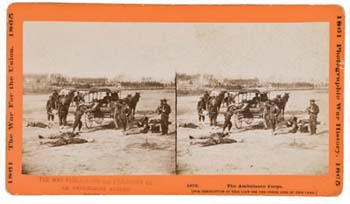1861 The War for the Union 1865 / Photographic War History, 1078. The Ambulance Corps
- ca. 1892 print after 1864 photograph of ambulance drill at Headquarters, Army of Potomac, Virginia
- Taylor and Huntington, The War Publication and Exhibition Co.
- Albumen stereoview photograph
8.2 x 16.1 cm., 3-3/16 x 6-3/8" image
- Catherine Carter Goebel, Paul A. Anderson Chair in the Arts Purchase, Paul A. Anderson Art History Collection, Augustana College 2010.18

Essay by Leslie Dupree, Director of Web Services and New Media
This image appears to show wounded men on a Civil War battlefield being loaded into a wagon. Closer examination, however, reveals that the wounded are neatly arranged for the composition and, though bandaged, have no bloodstains. What the image actually records is an ambulance drill taking place sometime between 1861 and 1864.
The Union's Ambulance Corps shown here was new, organized due to public pressure over the lack of trained ambulance crews. (Wagner). The Ambulance Corps would first be put to the test at the Battle of Antietam in 1862 (Dearth).
A few men are wearing baggy trousers and turbans-not the standard Union uniform. This costume reflected the "Zouave craze" that saw some American troops emulate the light infantry regiments of the French Army serving in North Africa ("The 5th"). The drummer at right may have been a bandsman pressed into ambulance service, as frequently happened.
Technology had advanced sufficiently by the Civil War to make it possible for photographers to capture events as they unfolded, although the work of hauling bulky equipment and chemicals in the field was difficult. Their plate glass negatives could make prints like this one using albumen, a substance found in egg whites. It was the most popular and inexpensive method of printmaking from about 1850-90 ("Albumen Print").
To produce a stereoview, a camera with two lenses takes two images about 2.5 inches apart (about the distance between our eyes). Even though they appear the same, the images are slightly different. When we look at the images through a stereoviewer, our brains put the two images together as a 3D picture.
Stereoviews were enormously popular before and after the Civil War, documenting everything from tourist sites to historic events. Families commonly had a stereoviewer and collection of photos they used for entertainment and education, and photographers leapt at the chance to provide this market with Civil War images.
Although the demand for war photos diminished after the war ended, stereoviews like this one were used as a sort of 1860s slideshow. The War Publication and Exhibition Co., which produced this print, sold a complete setup-stereoviewers, images and notes-to anyone who wanted to go on the lecture circuit (Gleeson).
